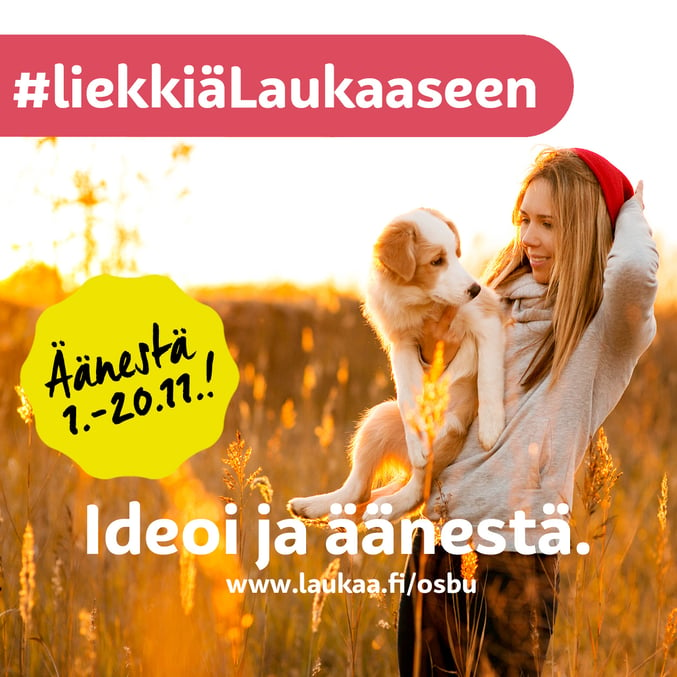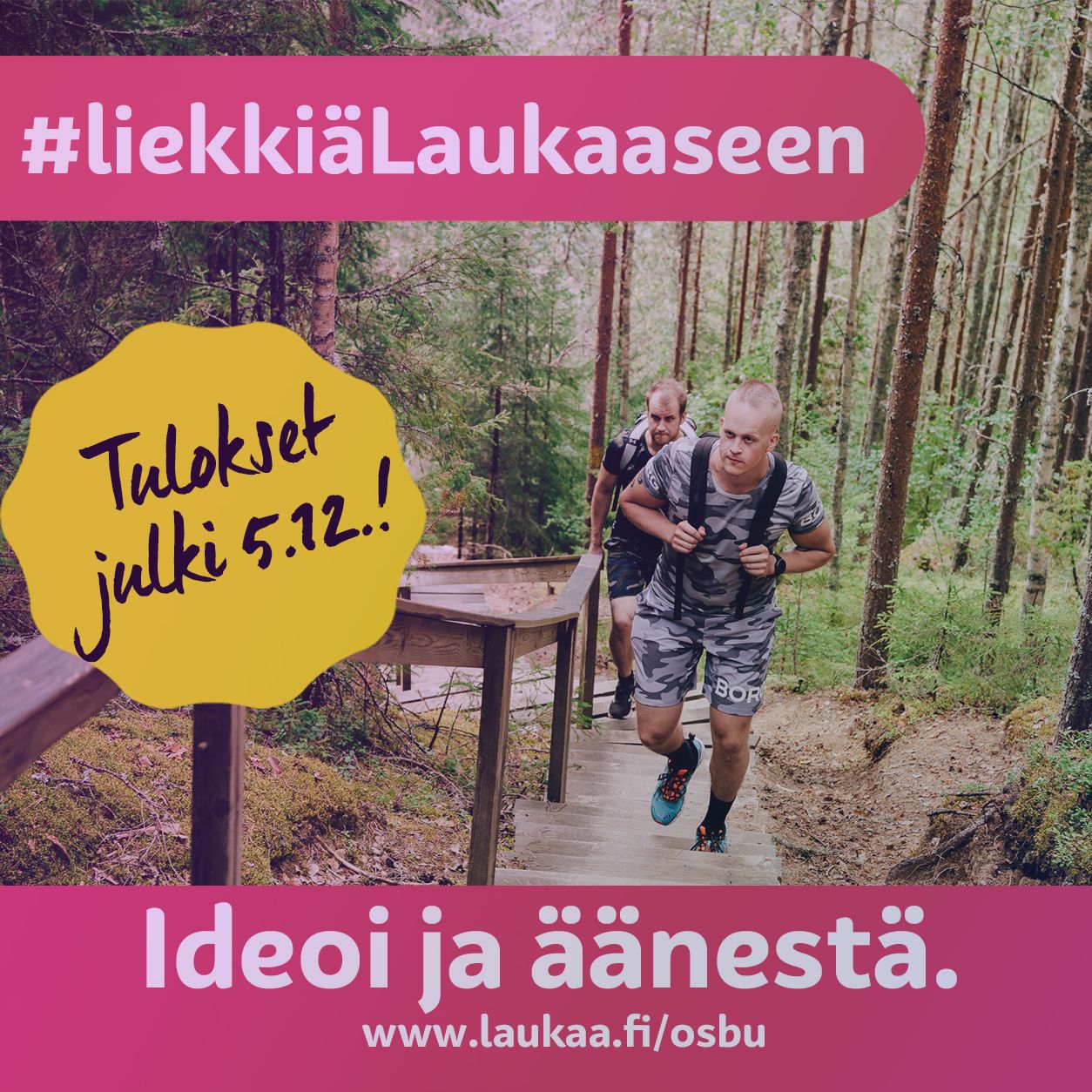Laukaa municipality

- 3rd largest municipality in Central Finland with 18 800 inhabitants
- The municipality is responsible for local care and education, leisure services, services for the disabled and elderly, sports and culture, etc.
- Laukaa utilized Orchidea to organize participatory budgeting during autumn 2022
Laukaa: piloting participatory budgeting
Laukaa piloted participatory budgeting for the first time in autumn 2022. The main concerns in advance were the capacity of their resources to process ideas and the participation level of community members. Laukaa sought to reduce the administrative burden and organized all steps of the participatory budgeting project on a single platform - Orchidea.
The citizen engagement and activity were a positive surprise, resulting in the selection of 6 winning ideas for implementation. However, the large number of ideas registered posed its own challenges for the campaign.
Administrative planner Kristiina Itäranta tells about the positive surprise:
"We didn't expect the number of ideas we received. It was more of a question beforehand whether we might not be receiving enough. It turned out to be a positive issue and more ideas came in than we expected."
Organizing participatory budgeting for the first time
The municipality of Laukaa decided to run its first pilot campaign on participatory budgeting in 2022. Planning was carried out in early summer, ideas were collected in late summer and discussion and voting took place in autumn. The winning projects would be implemented in 2023 with a budget of €50 000.
Participatory budgeting is an emerging trend that aims to engage residents in financial decision-making, and thereby increase local democracy and community spirit. The municipality is responsible for everything from the maintenance of outdoor facilities to education, so the campaign was unique in its multisectoral nature and scope. The broad scope of the campaign also meant that the Laukaa was open to proposals from all members of the community, from young people to the elderly.
The municipality of Laukaa started piloting the participatory budgeting program following an initiative by the council, in the hope of involving residents on a large scale. The challenge was that the experiment was the first one for them, so there were few established practices. Concerns around the piloting of participatory budgeting were mostly on the practical implementation of the ideas to deliver what was promised to the residents.
Eero Raittila, Director of Finance and Human Resources, was also concerned about the practical arrangements for the campaign beforehand:
"We wondered whether our organization had enough resources to manage the ideas, whether we could communicate in a way that would get people to submit their ideas, and whether we could organize the voting without technical problems."
To make it easier to process ideas, Laukaa searched for a tool where the whole process could be organized on one platform.
Implementing the whole participatory budgeting project with Orchidea
Laukaa found Orchidea through its articles on employee engagement and employee suggestion programs. Orchidea was eventually selected as the most straightforward solution for their needs as it also worked well for citizen involvement. According to Eero, the main factor that influenced the decision was that Orchidea is especially focused on innovation engagement, and the whole process from idea gathering to feasibility evaluation and voting could be done on a single platform:
"It's not that simple to implement a phased process like this with software, and cope with the large number of people involved."
The participatory budgeting program consisted of four phases: idea generation, feasibility assessment, voting, and publication of the results. Orchidea was used throughout each stage. Laukaa found it particularly useful that the whole process could be carried out with a single tool, and they didn’t need to navigate between different programs. According to Kristiina, there were also additional benefits experienced by using a single platform:
"A significant advantage is that you can have the whole internal discussion in Orchidea, instead of having to switch tools."
Orchidea made the processing of ideas smooth. According to Kristiina, the engagement features made it easy to participate in the voting phase. "It was great to be able to sort the topics by genre in the voting phase. Without that, it would have been a too large pool of ideas to go through for the person processing them".
The fact that Orchidea is designed for idea management made the process smooth. However, the amount of work involved in processing the ideas was a bit surprising, so Kristiina and Eero advise booking plenty of time for evaluation and processing, as well as testing the implementation of the process in the chosen tools beforehand.
"With up to 250 ideas, there were also challenges in managing them. The ideas were still in Orchidea as a bank, where they could be moved, deleted, added, and edited as needed. As a survey tool result, post-management would have been much more challenging."
According to Laukaa, publishing ideas on Orchidea was convenient, as they could be shared for example for voting in a user-friendly format both on mobile and desktop. There was no need to separately store and edit the proposals for publishing. Publishing the campaign on Orchidea made it much simpler to collect ideas and organize the voting. Orchidea made it possible to implement the whole participatory budgeting process and its data management within the same system.

Participation exceeded the expectations
The pilot was more successful than expected, although there were also challenges during the participatory budgeting process.
"We thought that around 100 ideas would be a good target for a municipality of our size, but we ended up with 2.5 times more."
The expert evaluation process sought to weed out proposals that would not be feasible. However, the large number of ideas was a surprise, and the evaluation took longer than planned. Although the number of ideas was a positive surprise, it also increased the workload, so Laukaa recommends allocating plenty of time to the processing and evaluating of the ideas.
During the autumn of 2022, 255 ideas were submitted by residents, of which 91 were published for vote based on feasibility evaluation. Citizen participation by voting was active, with around 1200 votes cast by residents, which meant a good turnout of around 6%.
The participatory budgeting pilot achieved a good turnout for ideas, with very close competition between the top candidates. In the end, the six projects that received the most votes were selected for implementation, including an airsoft game area, the development of a local beach, and the launch of the "Laukaan Lanit" gaming event.
Laukaa's tips for participatory budgeting
The participatory budgeting pilot provided many valuable lessons for the future.
- Invest in communication. In Laukaa, active communication paved the way for success. Participation was active and was perceived to be smooth by the participants. Laukaa communicated the campaign on its website, social media, traditional media, and in schools.
- Allocate sufficient time for evaluation and development. Book time on the calendars in advance and prepare the evaluators for the workload. Laukaa reserved 2 months for idea management, and they would recommend reserving even more time for that.
- Find the right participatory budgeting tools. Get a platform to manage ideas and information throughout the process. Be prepared for the multitude of ideas, and have a solid process in place for them.
- The coordinator has a lot on their plate in such a campaign. Set aside sufficient time for coordination.
- Consider how to offer the possibility to participate for everyone, and whether you want to exclude some participants. For example, decide if you require participants to have e-mail addresses and if participation is possible also in a non-electronic way.
- It is advisable to test the campaign on the platform before the launch so that any problems can be tackled in advance. This allows experts to test the evaluation and necessary changes can be implemented in advance.
The participatory budgeting pilot received a lot of positive feedback. Laukaa is now developing its way of implementing participatory budgeting in the future.

The participatory budgeting team in Laukaa was:
Eero Raittila, Director of Finance and Human Resources, and Kristiina Itäranta, Administrative Planner.
For more information on the campaign and the ideas selected for implementation, see: https://www.laukaa.fi/asukkaat/kunta-ja-paatoksenteko/strategiat/osallistuva-budjetointi/



.jpg)